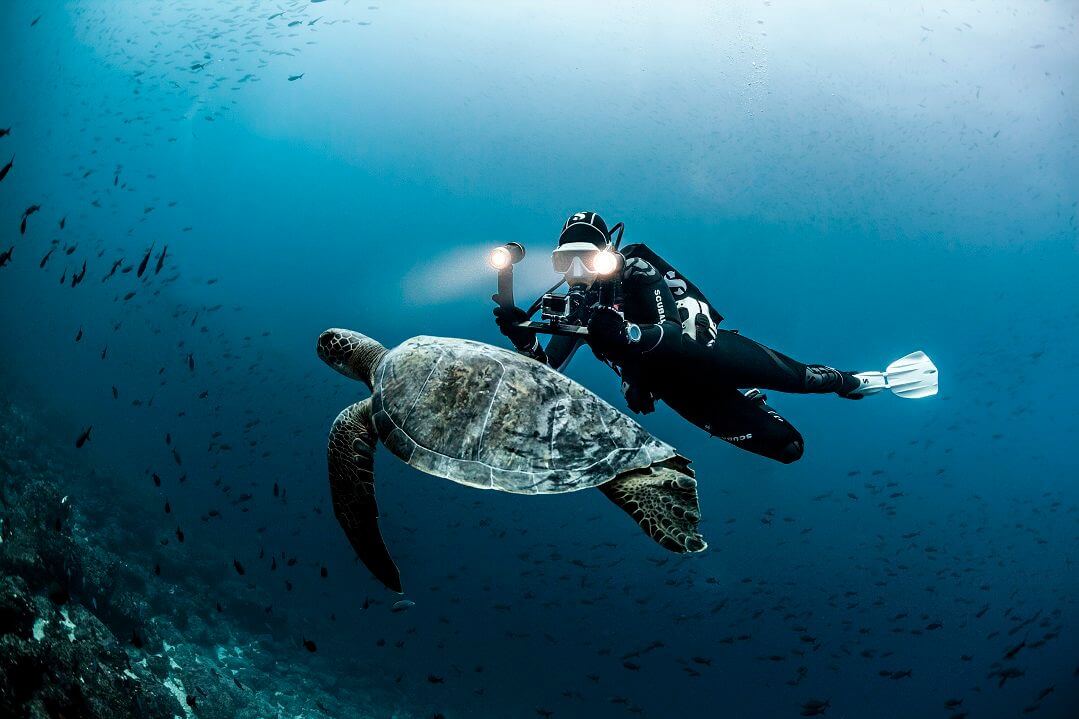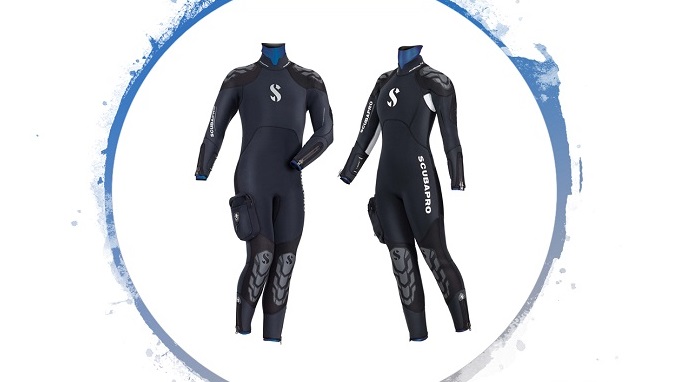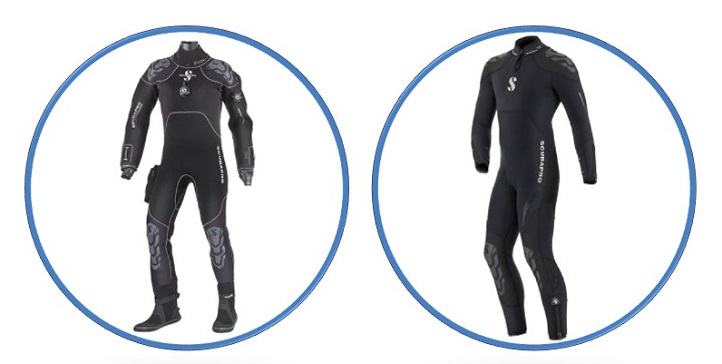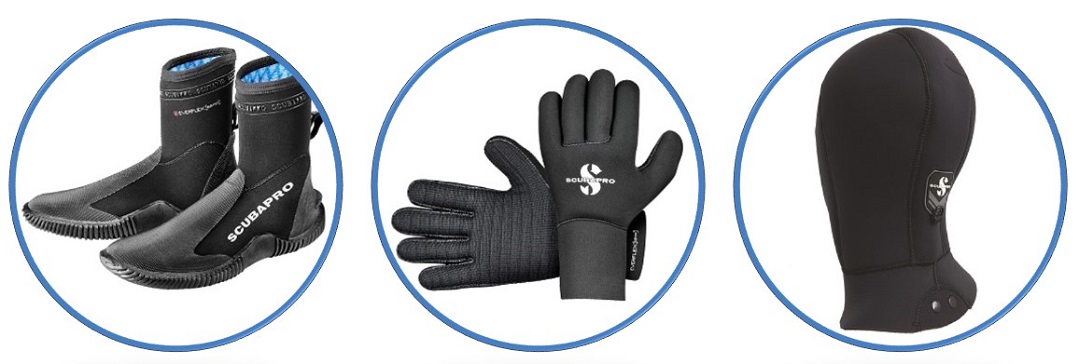Diving in a Semi-Dry Wetsuit
Positioned between the traditional 7mm wetsuit and the neoprene drysuit is a scuba diving suit that captures the best of both designs. Wetter than a drysuit and dryer than a wetsuit, it’s called the semi-dry wetsuit, or semi-dry suit, or just semi-dry, and it might change your whole perspective when it comes to diving warm in cold water.

What is a Semi-Dry Wetsuit?
A standard neoprene wetsuit works by trapping a layer of water between your skin and the neoprene, which is then warmed by your body heat. This, combined with the insulating properties of the neoprene, slows your body’s heat loss during the time you’re in the water. However, due to a variety of factors, including non-watertight seals and a less than perfect fit, when you’re at depth taking photos, exploring a wreck or just swimming along sightseeing, the water in your suit tends to get displaced by new water, which also has to be warmed by body heat. This “flushing†action varies in frequency, but every time your body has to heat a new layer of water, your heat reserve is diminished, and it becomes harder and harder to ward off the cold.
A drysuit, in contrast, works by keeping you completely dry. The suit, either neoprene or a trilaminate fabric blend, is in essence a shell that blocks water from coming in contact with your skin. Between your skin and the drysuit a layer of air is trapped. This air is warmed by your body heat, and combined with the wearing of thermal undergarments, provides your thermal protection. Since air is much easier to warm than water, wearing a drysuit minimises your body’s heat loss.
At first glance, a semi-dry wetsuit looks virtually identical to a standard wetsuit, but upon closer inspection you’ll notice that its wrist, ankle and neck seals are much closer to what you’d find on a drysuit. While not designed to completely block water entry like on a drysuit, these seals radically reduce the amount of water that can enter the suit.
A quality semi-dry wetsuit will also often employ a waterproof “dry†main zipper, the same kind normally found on drysuits. When combined with the sealing system, this creates a dive suit that still allows a very thin layer of water to enter to be warmed by the body, but that demonstrably minimises the amount of flushing action that occurs due to the suit’s superior sealing properties. Less flushing action means the body doesn’t have to continually heat up new water, which means less heat loss over the course of a day’s diving. So you end up getting all of the benefits of a wetsuit – fit, comfort, range of motion, minimal hydrodrag, with sealing benefits that more closely resemble a drysuit.

What are the Advantages of a Semi-Dry Suit?
There’s lots to be said for diving in a semi-dry suit. As previous stated, while not completely dry, these dive suits are substantially drier than a traditional wetsuit. They are easy to get in and out of, extremely comfortable, and they’re form-fitting for minimal hydrodrag.
The secret to a good semi-dry suit can be found in its seals and zipper. The higher quality the sealing system, the less water intrusion, and the more thermal warmth.
Take, for example, the NovaScotia 7.5mm semi-dry. This top-end semi-dry suit is not only made out of 100% Everflex neoprene for comfort, range of motion and durability, it comes with double zippered seals on the ankles and the wrists which are durable, extremely efficient at blocking water entry and easy to use. The fold-under neck seal is arguably the most effective type of seal you can have for this application, because the nylon inner lining makes it easy to pull the seal over your head, and then when you fold it under the smooth-skin neck seal is very comfortable and keeps water seepage to a minimum. This is especially true when combined with a hood – the smooth-skin neck seal connects seamlessly with the smooth-skin of the hood, creating a virtual watertight seal.
Not all semi-dry suits come with waterproof zippers, but the NovaScotia 7.5mm does. Its rear shoulder-to-shoulder, fully waterproof, YKK Aquaseal® Vislon® main zipper is basically the same dry zipper you’ll find on many drysuits, which completely blocks out water.
Put the dry main zipper and the wrist, ankle and neck sealing system together and you have a suit that keeps water entry to a minimum while maximising warmth.
Other Considerations
When shopping for a semi-dry suit also look for design features that extend the life of the suit as well as make your diving adventures more fun. Anti-abrasion shoulder patterns and prints protect the suit while eliminating BCD slippage, and kneepads provide both cushion and protection if you find yourself kneeling on a rocky bottom. Thigh-mounted utility pockets are handy for carrying extra gear, and small convenience items like hood hooks and straps on the arms for securing wrist instruments are nice touches that improve the overall diving experience.
And don’t forget, for a proper thermal protection system you’ll also need a pair of boots (check out the Everflex 5mm boot, for example), a pair of gloves (Everflex 5mm glove), and, of course, a hood. There’s no better partner for a NovaScotia 7.5mm semi-dry than a NovaScotia hood, and of course they are sold together.
Is a Semi-Dry Suit Right for You?
Semi-dry wetsuits are generally used in temperate to cold-water diving conditions, but the same could be said for drysuits and even full 7mm wetsuits. So is a semi-dry suit right for you? Maybe, maybe not. It all depends on your personal situation such as where you dive, how often you dive, and your tolerance for being cold.
For example, if you’re a temperate or cold-water diver who likes to dive deep, enjoys long bottom times and multi-dive days, or has a low tolerance for cold, a drysuit like this one might be the best choice.
If, on the other hand, being wet is one of the things you like about diving, or if you don’t tend to stretch out your bottom times, or if you don’t normally pile up a string of heat-reducing dives in a single day, a wetsuit might be the best choice.

However, if you dive like a drysuit diver – deep dives, long dives, multiple dives, but you like the fit, feel and flexibility of wearing a wetsuit, a semi-dry combines the comfort and range of motion of a wetsuit with thermal properties that are not that far off from what you’d get in a basic drysuit.
This is the sweet spot where a semi-dry wetsuit shines. Offering a snug-fitting, flexible dive suit with good thermal properties and minimal water intrusion at a lower cost than a basic drysuit, the semi-dry suit may just be your answer for staying very warm while remaining relatively dry. It’s the best of both worlds in cold-water, temperate water, and multi-dive thermal protection.
NovaScotia How To Video








